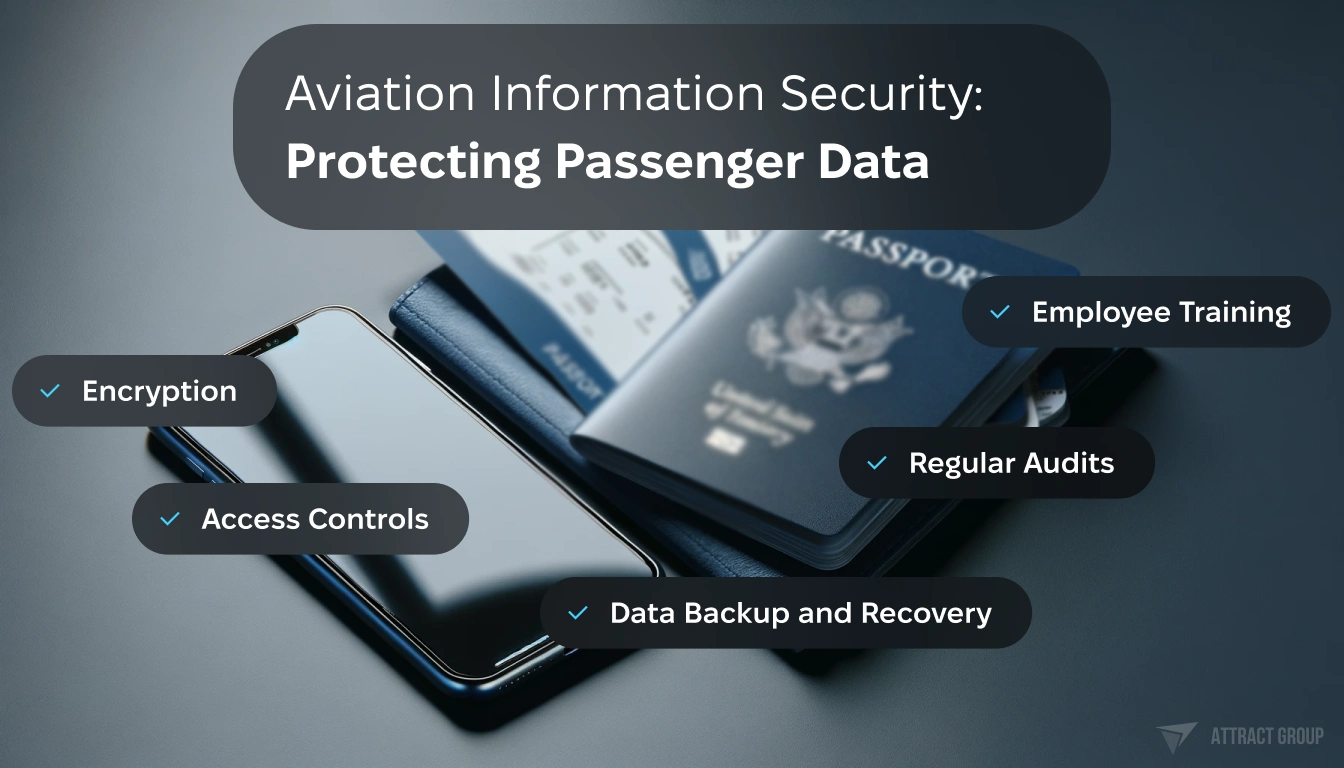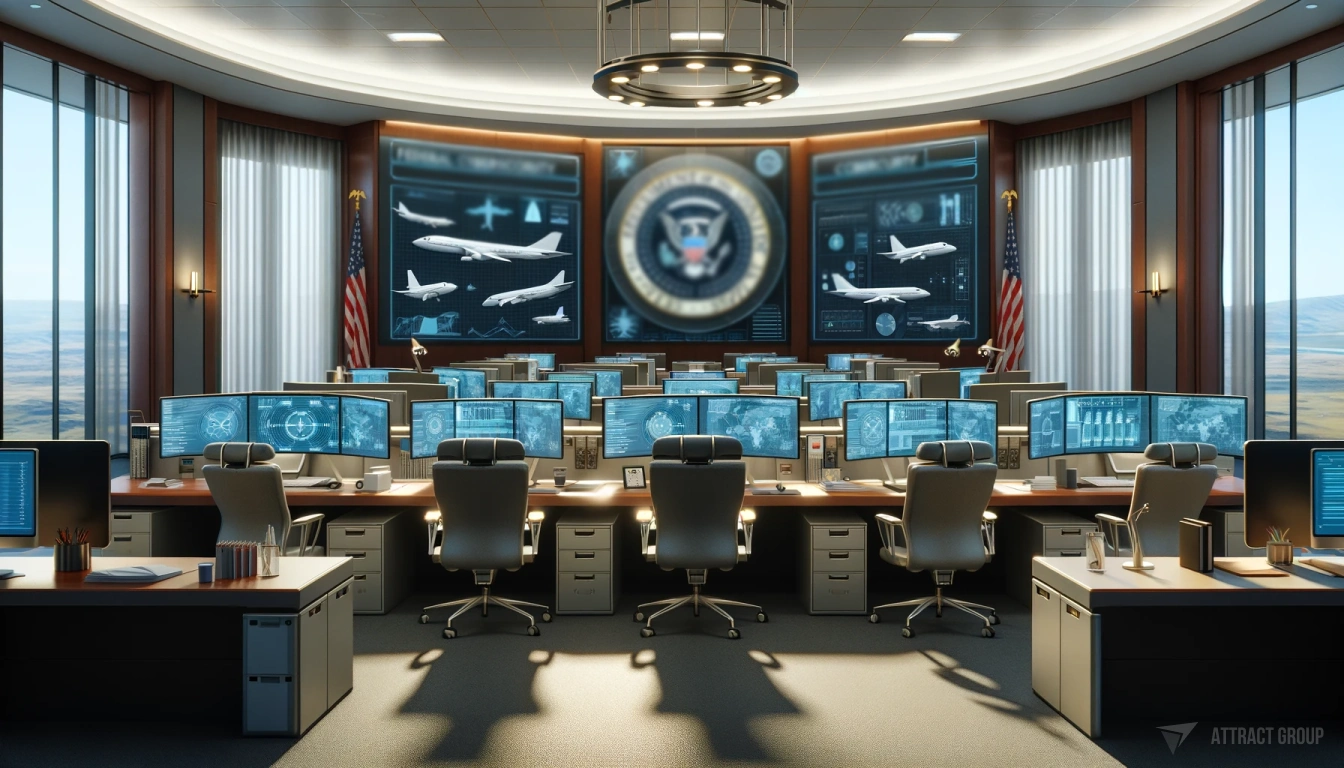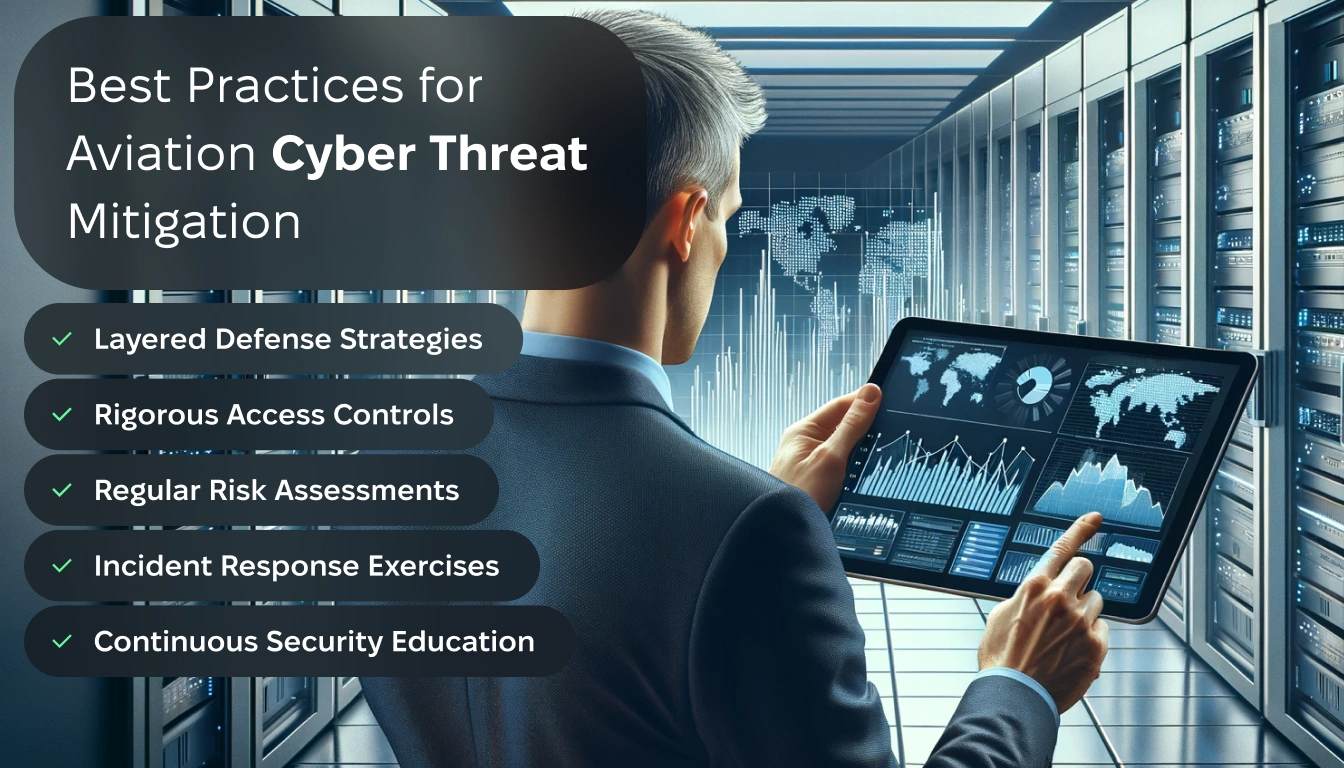Exploring the Importance of Aviation Cybersecurity in the USA
 2 January 2024
2 January 2024? Listen to the Summary of this article in Audio
As the aviation industry continues to embrace digitalization, the importance of aviation cybersecurity has grown significantly. From flight control systems to passenger data management, advanced technologies have vastly improved the efficiency and safety of air travel. However, these increasingly interconnected systems have also introduced vulnerabilities that cybercriminals are keen to exploit. With the potential for unauthorized access to flight control systems, airline cyber attacks, and breaches of airport cyber security, the stakes for the industry are high. In this article, we’ll delve into the essential aspects of aviation information security and explore the challenges and solutions in place to safeguard the U.S. airspace and its passengers in the digital age.
Key Takeaways
- The digitalization of aviation has led to increased cyber vulnerabilities in flight control systems, passenger data, and overall airport cyber security.
- Aerospace cybersecurity is a critical component for maintaining flight safety, national security, and data integrity for millions of air travelers.
- Recent airline cyber attacks have highlighted the need for robust aviation information security measures and frameworks.
- Collaboration between government and industry stakeholders is crucial for developing and maintaining a resilient aviation cyber ecosystem.
- Best practices for aviation cyber threat mitigation include risk assessments, advanced security technologies, and operational continuity strategies.
The Evolving Landscape of U.S. Aviation Cyber Threats
The U.S. aviation sector faces a multitude of evolving cyber threats, which include compromising flight data and control systems, stealing passenger information, and manipulating airline operations. The widespread adoption of applications for flight operations and customer services has further expanded the threat landscape. To defend against these increasingly sophisticated threats, a robust framework, tailored to the unique needs of aviation cybersecurity, is of paramount importance.
Recent cybersecurity incidents have underscored vulnerabilities within aviation infrastructure, emphasizing the urgent need for implementing resilient cybersecurity measures. For instance, the 2015 cyberattack on Polish LOT airlines and the 2018 cyberattack on Atlanta’s Hartsfield-Jackson International Airport highlight the significance of aviation cyber threat intelligence and proactive cybersecurity policies in aviation.

It’s essential to identify the most common cyber threats faced by the aviation industry:
- Hacking into flight control systems: Compromised flight control systems can lead to devastating consequences for flight safety and national security.
- Stealing sensitive passenger information: Cybercriminals can exploit this data for identity theft and other malicious activities, causing significant financial and reputational damages.
- Manipulating airline operations: Cyberattacks can disrupt airline schedules, cause flight cancellations, and impact airport services, leading to severe financial losses and passenger dissatisfaction.
- Malware infiltration and sabotage: Malware can infiltrate aviation systems and compromise their functionality, resulting in compromised flight safety and severe operational disruptions.
- Insider threats: Malicious or negligent insiders could exploit their access privileges to cause significant damage to aviation systems and data.
“As the aviation industry becomes more connected and reliant on software systems, the need for comprehensive and proactive aviation cybersecurity measures has never been greater.”
By staying informed about cyber threats and employing cyber threat intelligence, the U.S. aviation industry can enhance its defenses and develop robust cybersecurity policies that address aviation-specific threats. Efforts should be focused on fostering a security-driven culture, investing in advanced security technologies, and encouraging collaboration between stakeholders in both the private and public sectors to combat increasingly sophisticated threats.
Impact of Cybersecurity Breaches on Airline Operations
Cybersecurity breaches can severely impact airline operations by compromising the safety and consistency of flight operations, damaging the reputation, and causing financial loss. The aviation industry must rigorously assess and mitigate the risks associated with critical operations such as flight management systems, air traffic control, and maintenance operations data.

Understanding the Operational Risks of Cyber Threats
Operational risks in aviation include unauthorized interference with flight control systems, theft of flight navigation data, manipulation of maintenance operations, and compromise of air traffic control systems. These risks have the potential to cause significant disruptions in airline operations, endangering the safety of passengers and personnel, tarnishing the reputation of the airline, and incurring substantial financial costs.
Case Studies of Airline Cyber Incidents
Studying past cyber attack airlines incidents provide valuable insights into the nature of cyber threats and the strategies implemented to manage and mitigate their impact. Here are a few examples:
- LOT Polish Airlines: In 2015, a cyber attack on the airline’s flight plan systems resulted in the grounding of several flights, affecting over 1,400 passengers.
- Vietnamese Airports: In 2016, cybercriminals breached the websites and public address systems of multiple Vietnamese airports, posting political messages and attempting to gain unauthorized access to flight data systems.
- British Airways: In 2018, the airline experienced a sophisticated cyber attack, which led to the theft of personal and financial information of approximately 380,000 customers.
These case studies in aviation cybersecurity serve as practical examples for the industry and contribute to the continuous improvement of security measures.
Strategies for Operational Continuity Post-Breach

To minimize the impact of cyber attack on airlines and ensure operational continuity, aviation businesses should adopt the following strategies:
- Regular Training: Empower employees to recognize and manage cyber threats through ongoing training. Provide guidance on best practices for password management and reporting suspicious activities.
- Incident Response Planning: Develop and maintain a comprehensive incident response plan to facilitate the swift recovery of operations following a breach. Regularly review and update the plan to account for new and emerging threats.
- Backup and Recovery: Implement robust data backup and recovery protocols to safeguard critical information and systems, ensuring their swift restoration in the event of an attack.
- Collaboration with External Experts: Engage with cybersecurity professionals and government agencies to access the latest threat intelligence and industry-wide best practices in aviation cybersecurity.
By adopting a multifaceted approach to aviation cybersecurity, airlines can minimize disruption and protect the safety, security, and integrity of their operations and customers.
Our team specializes in implementing cybersecurity controls, policies, and processes tailored for aviation to meet key regulations like GDPR and CISA.
Aviation Information Security: Protecting Passenger Data
Protecting passenger data in the aviation industry is crucial, as unauthorized access to sensitive information, including passport details and travel itineraries, can result in significant financial and security repercussions. Implementing advanced security measures, like firewalls and intrusion detection systems, and enforcing strict data protection policies are essential in safeguarding this information.

As data breach prevention becomes a top priority, airlines are increasingly investing in state-of-the-art technologies and best practices.
| Security Measure | Description |
|---|---|
| Encryption | Encoding passenger data to protect it from unauthorized access and ensuring the integrity and confidentiality of the information |
| Access Controls | Granting data access only to authorized personnel with strong authentication mechanisms, such as multi-factor authentication |
| Regular Audits | Conducting routine assessments of the current information security measures in place, detecting vulnerabilities, and swiftly addressing them |
| Data Backup and Recovery | Maintaining secure, up-to-date backups of passenger data and having a solid recovery plan in case of a breach or system failure |
| Employee Training | Educating staff members about data protection in aviation, including recognizing phishing attacks, managing passwords, and reporting suspicious activities |
While these measures are essential, improving aviation information security also requires a culture of vigilance and collaboration within the industry. Numerous stakeholders, such as airlines, airports, and regulators, need to share information about potential cyber threats and work together to address them effectively.
“A successful aviation information security strategy must involve a combination of technology, processes, and people working together to safeguard passenger data and maintain trust in the industry.”
It is crucial for airlines and aviation stakeholders to adhere to these best practices. In addition to the safety risks associated with compromised passenger information, airlines must also address the financial damage associated with data breaches. Implementing comprehensive cybersecurity measures helps to prevent legal penalties and the erosion of customer trust.
- Adopt a proactive approach to identifying and addressing cyber threats to passenger data;
- Ensure compliance with international data protection standards and regulations;
- Implement regular security training and awareness programs for staff;
- Collaborate with industry peers and government agencies to improve aviation information security collectively;
- Continuously update and enhance security measures in response to the ever-evolving cyber threat landscape.
Strengthening aviation information security is essential for protecting passenger data from unauthorized access and maintaining the trust and safety of air travel. Through strategic collaboration, investment in advanced security technologies, and the establishment of robust data protection policies, the aviation industry can better defend against cyber threats and safeguard passengers’ sensitive information.
Encrypted Communication: The Backbone of Secure Aviation Communication

Encryption plays a critical role in protecting flight data and maintaining secure communications within the aviation industry. By encoding information to prevent unauthorized access, encryption ensures the confidentiality and integrity of sensitive flight and passenger data.
Role of Encryption in Safeguarding Flight Data
As aviation systems become increasingly interconnected, secure and encrypted communication is imperative for maintaining flight safety and preventing unauthorized access to critical information. Encryption in aviation software ensures that sensitive data, such as flight plans, navigation data, and communication between pilots and air traffic controllers, remains secure. This prevents cybercriminals from intercepting or manipulating the data, thereby mitigating the risk of aviation-related cyberattacks.
Challenges and Solutions for Implementing Robust Encryption
Implementing robust encryption protocols presents unique challenges within aviation due to the complex and interconnected nature of its systems. These challenges include:
- Ensuring compatibility and interoperability between multiple systems and devices
- Managing encryption keys and their distribution across various systems
- Complying with regulatory requirements and industry standards that may vary across countries and organizations
To address these challenges, the following solutions have emerged:
- Adopting advanced encryption technologies, such as quantum-resistant cryptography and end-to-end encryption, to strengthen data security
- Performing regular security audits to identify and remediate vulnerabilities and gaps in encryption implementation
- Establishing comprehensive access controls and secure authentication mechanisms to restrict unauthorized access to sensitive data
Given the importance of encryption in ensuring secure aviation communication, it is essential that the aviation industry continues to invest in advanced encryption technologies and best practices. By doing so, it can effectively mitigate the risks posed by cyber threats and maintain the integrity of critical data and systems.
Regulatory Frameworks Governing Aviation Cybersecurity
International cybersecurity standards are critical for meeting the stringent security requirements within the aviation industry. In order to maintain a strong security posture, the industry must tailor these standards to address specific aviation-related threats.
Compliance with Federal and International Cybersecurity Standards
Several key cybersecurity standards help ensure regulatory compliance in aviation. These include the International Organization for Standardization (ISO) and International Electrotechnical Commission’s (IEC) ISO/IEC 27001, which is the globally recognized standard for information security management systems (ISMS), and the NIST Cybersecurity Framework, a set of guidelines developed by the U.S. National Institute of Standards and Technology (NIST) to manage and reduce cybersecurity risks within specific sectors.

Compliance with these standards involves the implementation of risk management processes, robust information security controls, and continuous monitoring to address evolving threats. This level of preparedness not only strengthens the security posture of aviation companies but also ensures the industry meets its regulatory requirements.
The Impact of GDPR and CISA on U.S. Aviation
The European Union’s General Data Protection Regulation (GDPR) and directives from the U.S. Cybersecurity and Infrastructure Security Agency (CISA) have significant implications for U.S. aviation cybersecurity practices. Organizations operating within the aviation sector must adhere to these regulations in order to protect passenger data and maintain safe operational standards.
Industry compliance with GDPR and CISA directives is essential for aviation cyber threat mitigation, as these regulations provide a clear framework for managing and protecting sensitive data and critical infrastructure.
| Regulation | Key Focus Areas | Impact on U.S. Aviation |
|---|---|---|
| GDPR | Data protection, privacy, and data breach notification | U.S. aviation companies handling passenger data from EU citizens must implement robust data protection measures and adhere to strict GDPR requirements. |
| CISA Directives | Infrastructure security, supply chain risk management, and vulnerability management | CISA provides guidance and support in addressing cyber threats to critical infrastructure, ensuring U.S. aviation adopts effective cybersecurity measures. |
Ultimately, compliance with GDPR and CISA directives is crucial for safeguarding passenger data, maintaining safe operational standards, and fostering the growth of a secure aviation ecosystem.
Developing a Resilient Aviation Cybersecurity Ecosystem
Constructing a resilient aviation cybersecurity ecosystem necessitates the development of robust cybersecurity frameworks, leveraging advanced technologies, and fostering a culture of security awareness. Stakeholders must continuously adapt to the changing cyber threat landscape while complying with relevant regulations and best practices to ensure the security and safety of the aviation sector.

Establishing cyber resilience strategies for the aviation industry involves multiple layers of protection, encompassing the following:
- Identify and prioritize critical assets
- Develop a risk-based cybersecurity approach
- Implement robust security controls and policies
- Monitor and detect threats in real-time
- Develop an efficient incident response and recovery plan
Collaboration among various stakeholders in the aviation industry, such as airports, airlines, control towers, and manufacturers, is essential in creating a resilient cybersecurity ecosystem. This collaborative approach enables the sharing of threat intelligence and best practices while facilitating the development of comprehensive security policies.
Advanced technologies, such as artificial intelligence (AI), machine learning, and cloud computing, play a pivotal role in enhancing cybersecurity in aviation. AI and machine learning algorithms can analyze vast amounts of data at high speeds, automatically detecting and responding to cyber threats. Cloud computing enables the agile deployment of security tools and protocols while providing scalable infrastructure to support evolving cybersecurity needs.
“The aviation industry needs to create a security culture that not only understands current risks but is also resilient enough to respond swiftly to future threats. It’s a delicate balance of security investment, resource allocation, and continuous training.”
Creating a resilient cybersecurity ecosystem in aviation also requires addressing the human factor. Regular employee training and awareness programs can help build a security-conscious workforce that proactively identifies and mitigates cyber risks. This culture of security awareness, combined with robust policies and technological advancements, can help protect the aviation sector against ever-evolving cyber threats.
Technological Innovations and Cybersecurity in Aviation
The aviation industry is embracing cutting-edge technology to enhance cybersecurity and ensure safe and reliable operations. The rapid development and adoption of AI in aviation cybersecurity and machine learning for cyber defense have transformed the landscape while offering new solutions to combat cyber threats. Cloud-based technologies also play a significant role in achieving better data protection and system robustness, necessitating enhanced security measures for aviation.
Advancements in Artificial Intelligence and Machine Learning for Cyber Defense
AI and machine learning have emerged as powerful tools in various sectors and industries, including aviation. When integrated into cybersecurity strategies, they offer numerous benefits, such as:
- Real-time anomaly detection: AI algorithms can monitor network traffic and flight data systems to identify unexpected patterns or behaviors, spotting potential threats before they lead to serious consequences.
- Proactive threat mitigation: Machine learning models can be trained to recognize and classify different types of cyber threats, allowing for early detection and response to potential attacks.
- Enhanced automation: AI-powered cybersecurity solutions automate many manual tasks, reducing human error and accelerating incident response times.
- Adaptive learning: As cyber threats continue to evolve, machine learning capabilities allow security systems to adapt and learn from past experiences, improving overall defense mechanisms over time.

Adopting Cloud Solutions with Enhanced Security Measures
As the aviation industry adopts cloud solutions to boost efficiency and scalability, several inherent security challenges must be addressed. To establish a secure cloud environment for aviation and mitigate potential risks, key strategies need to be implemented, including:
- Stringent encryption: Applying advanced encryption technologies to safeguard sensitive data in the cloud, ensuring confidentiality and integrity.
- Access management: Implementing rigorous access controls to restrict unauthorized users from accessing, manipulating, or exfiltrating data.
- Continuous security evaluations: Regularly auditing cloud infrastructure and applications to identify and remediate security vulnerabilities promptly.
- Collaboration with cloud providers: Establishing strong partnerships with reputable cloud service providers that prioritize security and compliance.
By integrating enhanced security measures for aviation alongside AI-driven solutions and secure cloud infrastructure, the aviation industry can successfully safeguard digital assets, mitigate potential cyber threats, and maintain resilient operations.
Our experts can help implement AI and machine learning to detect threats, adapt defenses over time, and automate security processes.
Collaboration Between Government and Industry in Cyber Resilience
Collaborative efforts between government and industry stakeholders are essential for fostering aviation cyber resilience. By sharing best practices and cyber threat intelligence, both parties can engage in joint cybersecurity initiatives that promote a unified and effective response to evolving threats. Government-industry collaboration enables the aviation sector to address complex challenges and develop comprehensive strategies for combating cyber threats.

Examples of successful collaboration between government and the aviation industry include:
- Information sharing and analysis centers (ISACs) dedicated to the aviation sector, which enable stakeholders to exchange cybersecurity intelligence, best practices, and incident information.
- Partnerships between government agencies, such as the Federal Aviation Administration (FAA) and the Transportation Security Administration (TSA), and aviation industry groups for developing cybersecurity standards and guidelines.
- Joint cybersecurity exercises and training programs aimed at strengthening the industry’s ability to prevent, detect, and respond to cyber threats.
To further advance cooperation in aviation cyber resilience, government and industry stakeholders can consider:
- Establishing regular dialogue between aviation and cybersecurity experts to address emerging threats and technological developments.
- Developing joint aviation-specific cybersecurity research and development initiatives.
- Creating collaborative frameworks for coordinating incident response and crisis management efforts in the event of a cyber attack.
“Collaboration is at the core of a robust aviation cyber resilience strategy, as it empowers stakeholders to pool resources, expertise, and intelligence in mitigating cyber threats.”
In conclusion, collaboration between government and industry is indispensable for enhancing aviation cyber resilience. By working together, aviation stakeholders can effectively address current and emerging cybersecurity risks while promoting a safe and secure air transportation environment.
Best Practices for Aviation Cyber Threat Mitigation
Mitigating aviation cybersecurity threats requires a comprehensive approach encompassing a variety of best practices. These measures involve implementing layered defense strategies, rigorous access controls, regular risk assessments, incident response exercises, and engaging in continuous security education. This section discusses some essential best practices for bolstering aviation cyber threat defense.

Leverage our expertise to apply layered defenses, access controls, risk assessments, and training programs tailored for your aviation systems.
Layered Defense Strategies
Implementing layered defense strategies, like microsegmentation and lateral movement protection, is crucial in securing aviation networks and systems against cyber threats. Microsegmentation divides the network into smaller security zones, allowing for greater access control and data flow monitoring. Lateral movement protection prevents unauthorized access to sensitive information or vital systems after an initial breach has occurred.
Rigorous Access Controls
Applying stringent access control measures is vital in ensuring that only authorized personnel have entry to critical systems and data. Robust access control methods include multi-factor authentication, role-based access control, and regular reviews of user access privileges.
Regular Risk Assessments
Conducting regular risk assessments helps identify and address vulnerabilities in aviation systems and networks. Assessments should include penetration testing, vulnerability scanning, and analysis of threat intelligence to proactively identify and mitigate risks.
“To achieve a secure aviation ecosystem, it is essential to integrate continuous risk assessments and vulnerability management cycles.”
Incident Response Exercises
Practicing incident response exercises is an essential aspect of aviation cyber threat mitigation. Regularly performing these exercises helps organizations swiftly identify, contain, and eradicate cyber threats, while minimizing the overall impact on operations and reputation.
Continuous Security Education
Engaging in continuous security education plays a vital role in fostering a culture of cybersecurity awareness within the aviation industry. This includes conducting regular training sessions, workshops, and awareness campaigns for employees at all levels. Security education should cover various aspects, such as recognizing threats, managing passwords, and reporting suspicious activities.
| Best Practice | Description |
|---|---|
| Layered Defense Strategies | Utilizing microsegmentation and lateral movement protection to safeguard aviation networks and systems |
| Rigorous Access Controls | Implementing multi-factor authentication, role-based access control, and regular access privilege reviews |
| Regular Risk Assessments | Conducting penetration testing, vulnerability scanning, and threat intelligence analysis |
| Incident Response Exercises | Regularly practicing incident identification, containment, and eradication procedures |
| Continuous Security Education | Providing ongoing training, workshops, and awareness campaigns for employees |
Implementing these best practices in aviation cybersecurity is essential for building a resilient and secure aviation ecosystem capable of better managing and dealing with emerging cyber threats.
Conclusion
As the digital landscape of aviation continues to evolve, so too must the cybersecurity measures that protect it. The U.S. aviation sector faces the ongoing challenge of adapting to emerging cyber threats, such as airline cyber attacks and airport cyber security breaches, while maintaining compliance with national and international cybersecurity standards. Through collaboration, innovation, and vigilance, the industry is equipped to navigate the complexities of aviation cybersecurity, ensuring the safety and confidence of passengers and the resilience of aviation operations.
Developing a resilient aviation cybersecurity ecosystem involves creating a culture of security awareness and understanding the importance of protecting critical infrastructure. From aerospace cyber security measures to advanced technologies like artificial intelligence and machine learning, the aviation industry must continuously adapt and incorporate the best practices in cyber threat mitigation.
Our cybersecurity engineers can build and implement customized platforms to detect threats, ensure compliance, and safeguard your aviation systems.
Collaborative efforts between government and industry stakeholders play a vital role in strengthening aviation cybersecurity defense strategies. By sharing best practices, cyber threat intelligence, and engaging in joint initiatives, the aviation industry can forge a unified and robust defense against the ever-evolving cyber threats. In conclusion, the U.S. aviation industry’s commitment to staying ahead of cybersecurity challenges is crucial for maintaining the safety, security, and confidence of air travel now and in the future.
FAQ
What are the key threats faced by the aviation industry regarding cybersecurity?
Key threats include unauthorized interference with flight control systems, theft of passenger data, manipulation of airline operations, and vulnerabilities in applications for flight operations and customer services.
How do cybersecurity breaches impact airline operations and passenger safety?
Cybersecurity breaches can compromise the safety and consistency of flight operations, damage the reputation of airlines, and result in financial loss, impacting both airlines and passengers.
What measures are being taken to protect passenger data in the aviation industry?
Aviation companies are implementing advanced security measures like firewalls and intrusion detection systems and enforcing strict data protection policies to protect sensitive information, such as passport details and travel itineraries.
How does encryption play a role in aviation cybersecurity?
Encryption ensures the confidentiality and integrity of sensitive flight and passenger data by encoding information to prevent unauthorized access. Implementing robust encryption protocols is essential for maintaining secure communication within the aviation industry.
What regulatory frameworks and standards are essential for aviation cybersecurity compliance?
Compliance with international cybersecurity standards such as ISO/IEC 27001, the NIST Cybersecurity Framework, the EU’s GDPR, and directives from the U.S. CISA is critical for maintaining a strong security posture and safeguarding passenger data.
How can a resilient aviation cybersecurity ecosystem be developed?
Developing a resilient ecosystem involves implementing robust cybersecurity frameworks, leveraging advanced technologies, fostering a culture of security awareness, and adapting to the changing cyber threat landscape while complying with relevant regulations and best practices.
What role do AI and machine learning play in aviation cybersecurity?
AI and machine learning enhance cyber defense capabilities by enabling real-time anomaly detection in network traffic and flight data systems, proactively identifying and mitigating cyber threats.
How can government and industry collaboration help build cyber resilience in aviation?
Collaborative efforts between government and industry stakeholders aid in the sharing of best practices and cyber threat intelligence, engaging in joint cybersecurity initiatives, and fostering a unified, effective response to evolving threats.
What are some best practices for mitigating aviation cyber threats?
Best practices include implementing layered defense strategies, applying rigorous access controls, conducting regular risk assessments, performing incident response exercises, and promoting continuous security education.









